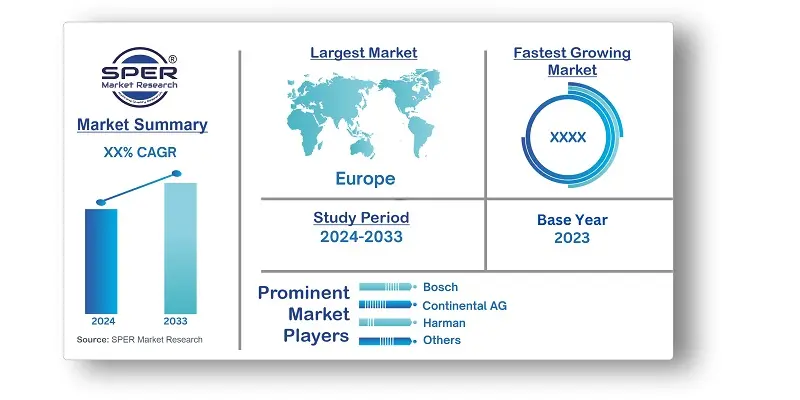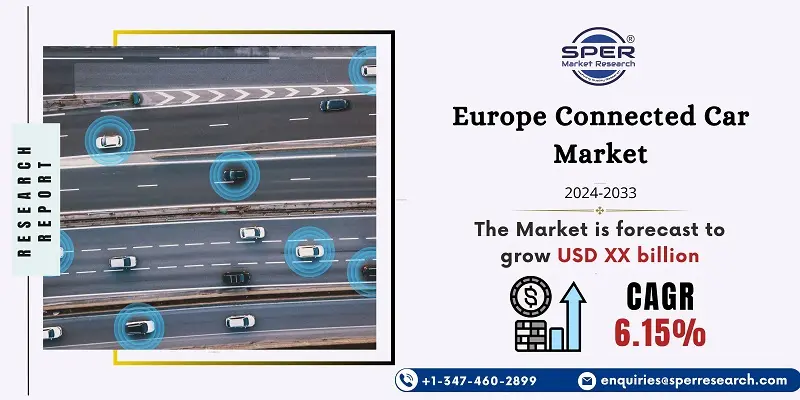
Europe Connected Car Market Trends, Share, Size, Demand, Revenue and Future Outlook
Europe Connected Car Market Growth, Size, Trends Analysis- By Technology, By Connectivity, By Application- Regional Outlook, Competitive Strategies and Segment Forecast to 2033
| Published: Oct-2024 | Report ID: AMIN24225 | Pages: 1 - 156 | Formats*: |
| Category : Automotive & Transportation | |||
- May 2022; Harman and Amazon announced their partnership for the development of cutting-edge software-defined cars that would help OEMs overcome a variety of reliability and safety concerns to jointly produce safe and trustworthy connected vehicle solutions.
- March 2022; Denso Corporation launched a software innovation project as a component of their new mobility-centered society. The training curriculum included optional exercises to teach ADAS visual sensor recognition technology and cloud computing engineering.


| Report Metric | Details |
| Market size available for years | 2020-2033 |
| Base year considered | 2023 |
| Forecast period | 2024-2033 |
| Segments covered | By Technology, By Connectivity, By Application. |
| Regions covered | Germany, United Kingdom, France, Spain, Italy, Benelux, Russia, Rest of Europe. |
| Companies Covered | Bosch, Harman, Airbiquity, Visteon, Continental AG, Audi AG, BMW Group, Autoliv Inc., Delphi Automotive LLP, Daimler AG, Verizon Communication, Denso Corporation. |
- Automotive manufacturers
- Technology providers
- Telecommunications companies
- Fleet management companies
- Insurance companies
- Government and regulatory bodies
- Consumers and end-users
- Automotive service providers
- Research institutions and think tanks
- Automotive aftermarket suppliers
| By Technology: | |
| By Connectivity: | |
| By Application: |
- Europe Connected Car Market Size (FY’2024-FY’2033)
- Overview of Europe Connected Car Market
- Segmentation of Europe Connected Car Market By Technology (5G, 4G/LTE, 3G, 2G, Others)
- Segmentation of Europe Connected Car Market By Connectivity (Integrated, Tethered, and Embedded)
- Segmentation of Europe Connected Car Market By Application (Telematics, Infotainment, Driving Assistance, and Others)
- Statistical Snap of Europe Connected Car Market
- Expansion Analysis of Europe Connected Car Market
- Problems and Obstacles in Europe Connected Car Market
- Competitive Landscape in the Europe Connected Car Market
- Impact of COVID-19 and Demonetization on Europe Connected Car Market
- Details on Current Investment in Europe Connected Car Market
- Competitive Analysis of Europe Connected Car Market
- Prominent Players in the Europe Connected Car Market
- SWOT Analysis of France Europe Connected Car Market
- Europe Connected Car Market Future Outlook and Projections (FY’2024-FY’2033)
- Recommendations from Analyst
1.1. Scope of the report1.2. Market segment analysis
2.1. Research data source
2.1.1. Secondary Data2.1.2. Primary Data2.1.3. SPERs internal database2.1.4. Premium insight from KOLs
2.2. Market size estimation
2.2.1. Top-down and Bottom-up approach
2.3. Data triangulation
4.1. Driver, Restraint, Opportunity and Challenges analysis
4.1.1. Drivers4.1.2. Restraints4.1.3. Opportunities4.1.4. Challenges
4.2. COVID-19 Impacts of the Europe Connected Cars Market
5.1. SWOT Analysis
5.1.1. Strengths5.1.2. Weaknesses5.1.3. Opportunities5.1.4. Threats
5.2. PESTEL Analysis
5.2.1. Political Landscape5.2.2. Economic Landscape5.2.3. Social Landscape5.2.4. Technological Landscape5.2.5. Environmental Landscape5.2.6. Legal Landscape
5.3. PORTERs Five Forces
5.3.1. Bargaining power of suppliers5.3.2. Bargaining power of buyers5.3.3. Threat of Substitute5.3.4. Threat of new entrant5.3.5. Competitive rivalry
5.4. Heat Map Analysis
6.1. Europe Connected Car Market Manufacturing Base Distribution, Sales Area, Product Type6.2. Mergers & Acquisitions, Partnerships, Product Launch, and Collaboration in Europe Connected Car Market
7.1. Europe Connected Car Market Size, Share and Forecast, By Technology, 2020-20267.2. Europe Connected Car Market Size, Share and Forecast, By Technology, 2027-20337.3. 5G7.4. 4G/LTE7.5. 3G7.6. 2G
8.1. Europe Connected Car Market Size, Share and Forecast, By Connectivity, 2020-20268.2. Europe Connected Car Market Size, Share and Forecast, By Connectivity, 2027-20338.3. Integrated8.4. Tethered8.5. Embedded
9.1. Europe Connected Car Market Size, Share and Forecast, By Application, 2020-20269.2. Europe Connected Car Market Size, Share and Forecast, By Application, 2027-20339.3. Telematics9.4. Infotainment9.5. Driving Assistance9.6. Others
10.1. Europe Connected Car Market Size and Market Share By Region (2020-2026)10.2. Europe Connected Car Market Size and Market Share By Region (2027-2033)10.3. Europe
10.3.1. Germany10.3.2. United Kingdom10.3.3. France10.3.4. Spain10.3.5. Italy10.3.6. Benelux10.3.7. Russia10.3.8. Rest of Europe
11.1. Bosch
11.1.1. Company details11.1.2. Financial outlook11.1.3. Product summary11.1.4. Recent developments
11.2. Harman
11.2.1. Company details11.2.2. Financial outlook11.2.3. Product summary11.2.4. Recent developments
11.3. Airbiquity
11.3.1. Company details11.3.2. Financial outlook11.3.3. Product summary11.3.4. Recent developments
11.4. Visteon
11.4.1. Company details11.4.2. Financial outlook11.4.3. Product summary11.4.4. Recent developments
11.5. Continental AG
11.5.1. Company details11.5.2. Financial outlook11.5.3. Product summary11.5.4. Recent developments
11.6. Audi AG
11.6.1. Company details11.6.2. Financial outlook11.6.3. Product summary11.6.4. Recent developments
11.7. BMW Group
11.7.1. Company details11.7.2. Financial outlook11.7.3. Product summary11.7.4. Recent developments
11.8. Autoliv Inc
11.8.1. Company details11.8.2. Financial outlook11.8.3. Product summary11.8.4. Recent developments
11.9. Delphi Automotive LLP
11.9.1. Company details11.9.2. Financial outlook11.9.3. Product summary11.9.4. Recent developments
11.10. Daimler AG
11.10.1. Company details11.10.2. Financial outlook11.10.3. Product summary11.10.4. Recent developments
11.11. Others
SPER Market Research’s methodology uses great emphasis on primary research to ensure that the market intelligence insights are up to date, reliable and accurate. Primary interviews are done with players involved in each phase of a supply chain to analyze the market forecasting. The secondary research method is used to help you fully understand how the future markets and the spending patterns look likes.
The report is based on in-depth qualitative and quantitative analysis of the Product Market. The quantitative analysis involves the application of various projection and sampling techniques. The qualitative analysis involves primary interviews, surveys, and vendor briefings. The data gathered as a result of these processes are validated through experts opinion. Our research methodology entails an ideal mixture of primary and secondary initiatives.



Frequently Asked Questions About This Report
PLACE AN ORDER
Year End Discount
Sample Report
Pre-Purchase Inquiry
NEED CUSTOMIZATION?
Request CustomizationCALL OR EMAIL US
100% Secure Payment






Related Reports
Our Global Clients
Our data-driven insights have influenced the strategy of 200+ reputed companies across the globe.




















